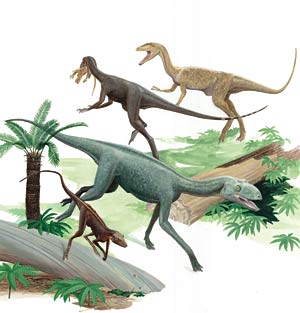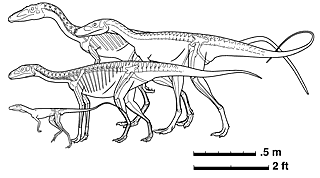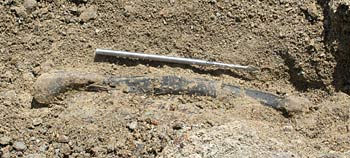UC Berkeley Press Release
Rise of dinosaurs not so rapid after all
BERKELEY – Fossils discovered in the oft-painted arroyos of northern New Mexico show for the first time that dinosaurs and their non-dinosaur ancestors lived side by side for tens of millions of years, disproving the notion that dinosaurs rapidly replaced their supposedly outmoded predecessors.
 The two carnivorous dinosaurs and two dinosaur ancestors discovered at Ghost Ranch, New Mexico, by UC Berkeley and American Museum of Natural History scientists. In the rear is an unidentified coelophysoid dinosaur, and in front of that, the dinosaur Chindesaurus bryansmalli munching on an animal that is an ancestor of today's crocodiles. The two dinosaur precursors are in the foreground: a quadrupedal herbivore similar to Silesaurus and, in the very front, the newly described Dromomeron romeri. (Drawing by Donna Braginetz for UC Berkeley, courtesy of Science magazine) |
The fossils were excavated from the Hayden Quarry at Ghost Ranch, an area made famous through the paintings of Georgia O'Keefe, by a team of paleontologists from the University of California, Berkeley, the American Museum of Natural History and The Field Museum. The finds, including fossil bones of a new dinosaur predecessor the researchers have named Dromomeron romeri, are described in a cover story in the July 20 issue of Science.
"Up to now, paleontologists have thought that dinosaur precursors disappeared long before the dinosaurs appeared, that their ancestors probably were out-competed and replaced by dinosaurs and didn't survive," said co-author Kevin Padian, professor of integrative biology at UC Berkeley and a curator in the campus's Museum of Paleontology. "Now, the evidence shows that they may have coexisted for 15 or 20 million years or more."
According to primary authors Randall Irmis and Sterling Nesbitt, graduate students, respectively, at UC Berkeley and at New York's American Museum, the new bones provide anatomical information that tells paleontologists about the evolution of dinosaur precursors, their transition into true dinosaurs and how dinosaurs diversified.
| Dinosaur excavation |
|
|
"Finding dinosaur precursors, or basal dinosauromorphs, together with dinosaurs tells us something about the pace of changeover," Irmis said. "If there was any competition between the precursors and dinosaurs, then it was a very prolonged competition."
An alternative hypothesis held that the sudden extinction of many animals in the Late Triassic period allowed dinosaurs to diversify and eventually populate the globe. Based on the new findings, however, "quite a few of the groups proposed to go extinct survived well into the Late Triassic," Irmis said.
Dinosaurs and many other animals, including mammals, lizards, crocodiles, turtles and frogs, arose in the Late Triassic, between 235 and 200 million years ago, but it was only in the Jurassic period 200-120 million years ago that dinosaurs dominated the planet and all their predecessors vanished. Fossils of Late Triassic dinosaurs are thus rare, and until 2003, when a creature called Silesaurus (SIGH leh SOAR us) was discovered in Poland, no dinosaur precursors had been found from the Late Triassic either.
At the Hayden Quarry, Irmis and Nesbitt found both early dinosaurs and dinosaur precursors, not to mention bones of crocodile ancestors, fish and amphibians, all dating between 220 and 210 million years ago. The Science report also details their discovery of the leg bones (femurs) of the carnivorous Chindesaurus bryansmalli (SHIN dee SOAR us) and a close relative of the carnivorous Coelophysis (SEE low FIE sis), a well-known Triassic dinosaur. Both walked on two legs, reminiscent of the much later Velociraptor depicted in the 1993 film "Jurassic Park" as a cunning pack hunter.
 Comparative sizes of (back to front) an unidentified coelophysoid dinosaur; the dinosaur Chindesaurus bryansmalli; a quadrupedal herbivore similar to the dinosaur precursor Silesaurus; and the newly described dinosaur precursor Dromomeron romeri. (Drawing by Donna Braginetz for UC Berkeley) |
The first dinosaur precursor found at the site was Dromomeron romeri (Dro MOE mer on RO mer eye), a creature related to a 235 million-year-old Argentinian middle Triassic precursor called Lagerpeton (LAG err peh TON). Dromomeron was between three and five feet long, and possibly bipedal, the authors concluded. The other precursor was an unnamed, quadrupedal, beaked grazer about three times the size of Dromomeron and similar to Silesaurus.
"Everyone thought that all the dinosaur precursors were little carnivorous, bipedal animals," Irmis said. "This Silesaurus-like creature still has the gestalt of a dinosaur, but to find a quadrupedal, herbivorous one was kind of unexpected."
Irmis noted that during the Late Triassic, the world's continents were a single supercontinent called Pangea, and the New Mexico site was then near the equator. Argentinian dinosaur precursors, on the other hand, come from a middle latitude site in Pangea. This could indicate a geographic variation in survival of dinosaur precursors, or merely reflect the paucity of fossil finds, he said.
Ghost Ranch, near the town of Abiquiu, where artist O'Keefe lived, is known for its Triassic fossils excavated from the Chinle Formation. Many of them are kept in the Ruth Hall Museum of Paleontology at the headquarters of the ranch, which is operated as a retreat and conference center by the Presbyterian Church. UC Berkeley and American Museum scientists have visited the site at various times over the past 80 years, and collectors working for famed paleontologist Edward Drinker Cope discovered the first Coelophysis dinosaur fossil there in 1881.
Hayden Quarry, however, is a relatively new excavation site started after a hiker discovered fossils there in 2002. After Ghost Ranch paleontologist Alex Downs showed some of these fossils to Irmis and Nesbitt in 2005, the two graduate students arranged to excavate at the site in the summer of 2006 and again earlier this summer, with assistance from members of the public enrolled in a week-long summer paleontology seminar.
 A dinosaur bone discovered at the Hayden Quarry site, Ghost Ranch, New Mexico. (Randall Irmis/UC Berkeley photo) |
"In the summer of 2005, we spent a day at the quarry and found half a dozen dinosaur bones, which is unheard of for Triassic deposits," Irmis said. "I have spent summers doing field work at the Petrified Forest National Park, which has rocks of the same age, and we were lucky to find half a dozen dinosaur bones in an entire season. So, we knew this was a really special site."
Altogether, they found 1,300 fossil specimens, including several complete bones. None of the remains described in the paper formed a complete skeleton. Most came from a 20- by 10-foot site. The research team continues to excavate at three sites in the quarry and is sifting through the debris for smaller fossils of mammals, lizards and fish.
"Randy and Sterling were clever to find all this stuff; these guys have just done terrific work," Padian said. Noting that Nesbitt obtained his B.S. in integrative biology from UC Berkeley, Padian added, "They are continuing the UC Berkeley tradition of discoveries from the Triassic, at the beginning of the dinosaurs."
In addition to Irmis, Nesbitt, Padian and Downs, other authors are graduate student Nathan D. Smith of Chicago's Field Museum of Natural History, graduate student Alan H. Turner of the American Museum, and graduate student Daniel Woody of the University of Colorado at Boulder.
Field research was funded by the National Geographic Society, the Theodore Roosevelt Memorial Fund and the Jurassic Foundation. Irmis and Nesbitt were also supported by a National Science Foundation Graduate Fellowship.

